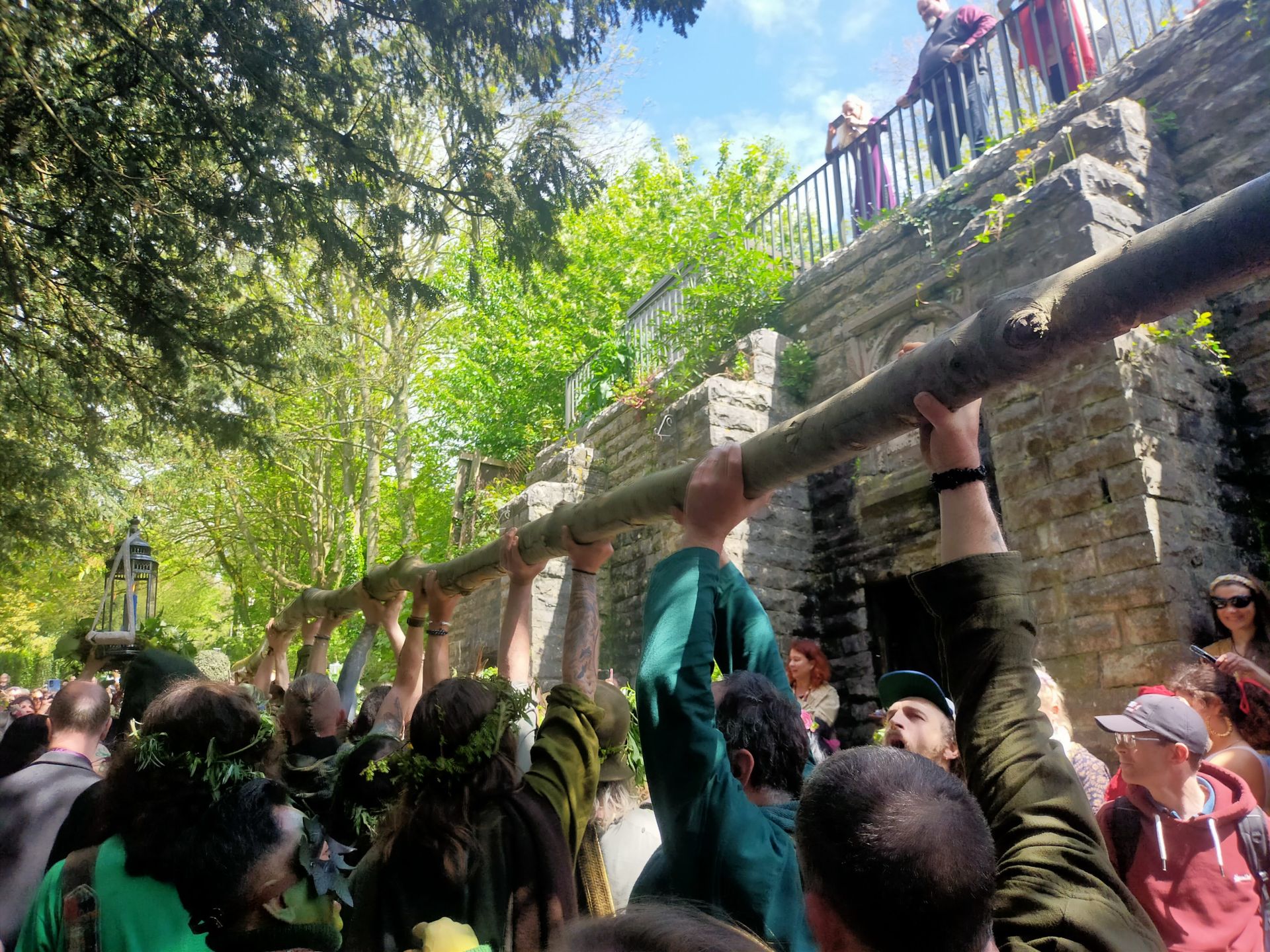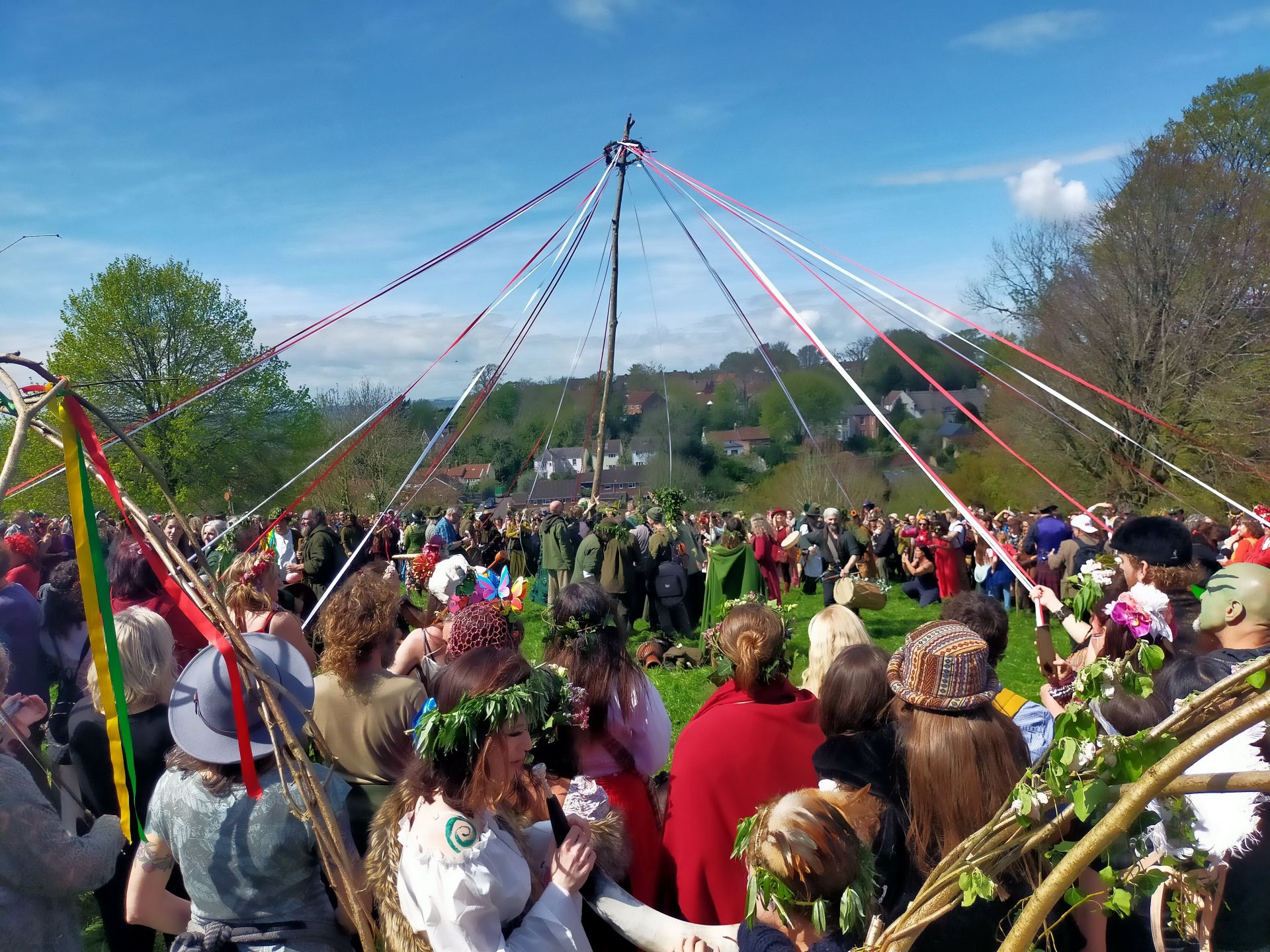
Report from Claire Slack re Estella Canziani Bursary 2023

A Week in Glastonbury
Thanks to the Estella Canziani Post-graduate Bursary for Research 2023, I was able to undertake my first fieldwork trip to Glastonbury in April/May 2023 as part of my Professional Doctorate in Heritage with the University of Hertfordshire. I came home a week later with over 19,000 words of fieldwork notes and a head full of ideas, inspiration and further questions to explore. My biggest challenge as I sit down to write this report is how to reduce seven incredible days of maypoles, clooties, love locks, kissing gates, sound meditations, chance meetings, rituals, druids, green men, goddesses, dragons, ravens, several Merlins and even a Tibetan Long Horn down into one thousand words.
My project, entitled 'Sharing Sacred Spaces: Engagements with the Contemporary Heritage of British Pagan Sacred Sites,' updates and expands on the valuable groundwork set by academics such as Jenny Blain and Robert Wallis in sacred site studies. Throughout this project, I am exploring aspects of ritual (and ritual deposits), folklore, visitor experience, heritage, interpretation, and conservation that weave together at these historically significant sites where sacrality has been formed through usage, story, landscape and perhaps something more intangible such as gods, goddesses or spirits of the land itself.
My week in Glastonbury focused on the Glastonbury Tor landscape, a landscape mentioned seventy-one times in a 2022 survey on sacred sites I conducted with 508 British Pagans. My fieldwork included participant observations and informal conversations with participants that took place in St Michael's Tower, the fields at the base of the Tor and the surrounding landscape (including Fairfield, Bushy Combe, Avalon Orchard and Moneybox Field where the Bridey Bell resides) and the White Spring. I also interviewed rangers from the National Trust and the Keepers of the White Spring to get a better understanding of the challenges and successes involved in managing and conserving these complex sites. Unfortunately, I was unable to conduct research at the Chalice Well that also forms a key part of this sacred landscape, but I was able to visit on a personal level and make use of their gift shop to pick up some useful texts for future reading.
Choosing to study Glastonbury over the Beltane week, possibly the busiest time of year for the town except perhaps Samhain on 31 October when the weather would be less favourable to a wandering researcher, I had already carefully planned my limited time to ensure the richest data I could possibly gather, finally settling on attending the Glastonbury Dragon ceremony that took place on Sunday 30 April, the Beltane procession and maypole ceremony at Bushy Combe on 1 May and several tactical hours spent at various points within the Glastonbury Tor landscape observing, chatting and recording the ritual deposits that I found there.
'All Hail the Green Men, All Hail the Maypole'
1 May proved to be my busiest day as I observed and recorded the Beltane festivities themselves. On speaking to the Green Men who organise the Beltane celebrations, I learned that the procession and ceremony began about twenty years ago as a much smaller affair but had grown to one of the biggest events in the Glastonbury calendar. The day focused on a large ash maypole that the Green Men harvest from Wearyall Hill the day before, at the same time as a hole is dug at Bushy Combe by a group of women. Here the maypole represents the masculine in this modern take on a grand-scale fertility ritual, with the hole on Bushy Combe being the feminine. There was a real feeling of shared tradition and community as the maypole was prepared in the Beckets Inn that morning with hundreds of men and women meeting to paint ivy and oak leaves on faces, dress in green robes covered in foliage and carve the maypole with runes, moons, ogham, the Awen, hearts, names, and a giant penis right on the end.
The procession and subsequent ceremony had an estimated five thousand people filling the streets of Glastonbury from the High Street to Bushy Combe where the ceremony of raising the maypole, crowning the May King and Queen, and the maypole ribbon dance took place. There were people wearing every kind of costume or clothing you could imagine, with people of many different races, ages and genders in the crowds and the atmosphere jumped between almost solemn and respectful to a party that Dionysus would be proud of. During the procession, there were near constant shouts of 'Hail the Green Men! Hail the Maypole!', chants of 'Earth my body, water my blood, air my breath and fire my spirit' and the occasional round of, 'Hi ho, hi ho, its off to work we go, it's the green men's job to carry the knob, hi ho, hi ho, hi ho, hi ho…' Several hours later, once the festivities had quietened and the ceremony concluded, the maypole was led back to the White Spring where a section was cut off and offered to the fire before it was placed within the walls of the spring itself, to be replaced at Beltane 2024.
A Layered Landscape of Belief and Tradition
Throughout my week of fieldwork, I observed everything from quiet personal meditation to mass community ritual, including aspects we may consider Pagan in nature (in a contemporary sense) but also drawn from other religions and spiritualities globally. Speaking to and observing many visitors over several days has offered me only a glimpse into this complex landscape which is littered with the ghostly deposits of rituals past and present, deposits at the White Spring seeming purposefully placed with fresh flowers, ribbon and painted stone as opposed to the remnants of candle wax, symbolic graffiti and broken glass in St Michael's Tower. Both visitors and residents seem drawn to Glastonbury from a multitude of belief systems to connect, re-enchant and recharge, with many mentioning the energies that the town and especially the Tor hold. One thing that was clear was the great sense of connection to the stories, history and beliefs to be found in Glastonbury that help make the town sacred to so many and that I hope to explore further very soon.
Postcards from the Fieldwork
 Costumed green men (and women) prepare for the Beltane 2023 festivities at the Beckets Inn in Glastonbury; photo Claire Slack[caption id="attachment_1936" align="alignleft" width="300"]
Costumed green men (and women) prepare for the Beltane 2023 festivities at the Beckets Inn in Glastonbury; photo Claire Slack[caption id="attachment_1936" align="alignleft" width="300"]
The Glastonbury Maypole (cut from Wearyall Hill the day before) passes the White Spring on the way up to the Beltane ceremony at Bushy Combe accompanied by chants of 'Earth my body, water my blood, air my breath and fire my spirit' from the Green Men that carry it.; photo Claire Slack

The 2023 Glastonbury Maypole is raised at Bushy Combe after the handfasting of the May King and Queen. The sound of a hurdy gurdy strikes up and the ribbon dances begin; photo Claire Slack
< Brian McConnell Book Award 2023 Katharine Briggs Lecture 2022: recording >
Tagged under: Research
